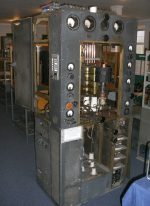SWBs Galore
From Ron Kitchen
 When I passed out from RAF Cranwell and was posted to RAF West Drayton, I had the job of testing SWBs in vehicles. It seemed to be a bad choice of location for high capital cost equipment with Doodlebugs and their successors being around in that area. We had a gun on the HQ roof but it was never manned as a successful hit might have proved to be a massive own goal! As it happened, in my time there the nearest one was a quarter of a mile away. My next contact with SWBs was when I was posted to Egypt (El Hagg) where we had two underground stations. I was involved in the one which had both the SWBs (I think SWB 10 but my memory is not reliable), and the installation was used with teleprinter circuits. We also had aircraft channels using American lower power equipment. Every time we had a sandstorm, the American equipment went into what we called hysterics – and often incurred damage. The SWB carried on without a problem – in fact the only problem was occasional excessive local temperature – red line operating!
When I passed out from RAF Cranwell and was posted to RAF West Drayton, I had the job of testing SWBs in vehicles. It seemed to be a bad choice of location for high capital cost equipment with Doodlebugs and their successors being around in that area. We had a gun on the HQ roof but it was never manned as a successful hit might have proved to be a massive own goal! As it happened, in my time there the nearest one was a quarter of a mile away. My next contact with SWBs was when I was posted to Egypt (El Hagg) where we had two underground stations. I was involved in the one which had both the SWBs (I think SWB 10 but my memory is not reliable), and the installation was used with teleprinter circuits. We also had aircraft channels using American lower power equipment. Every time we had a sandstorm, the American equipment went into what we called hysterics – and often incurred damage. The SWB carried on without a problem – in fact the only problem was occasional excessive local temperature – red line operating!
On leaving the RAF after 14 years and joining Marconi I found myself again involved with transmitters of all sorts, this time from the radiation safety point of view. This included visiting quite a few customers’ premises.
There has been quite a lot about SWBs in a number of issues of the newsletter. For all you non-Comms folk, like me, who are not all that sure what the SWB is, above is a photo of one (from the RAF Museum, Henlow’s collection). This model is the SWB 8. SWB, for short waveband transmitter – affectionately known as the ‘Swab’ – whose model numbers ran into the high ’teens from the original designed in the 1920s by CS Franklin. The SWB sold in its hundreds to civil and military customers worldwide. It was a staple product contributing to the company’s success over many years. A Marconi icon. Ed.
 Here is another picture of a SWB, the most powerful of the series at 100kW carrier, when it was installed along with five other SWBs at Tebrau in Malaysia. This station was eventually closed and the BBC relay moved to Kranjie in Singapore. Until a few years ago there was still at least one SWB18 operating, at Ekala in Sri Lanka. The transmitter could not be frequency changed as the hydraulic motors were worn out and the valves (tubes) had been changed for ones manufactured by Brown Boveri, the original were English Electric. Webmaster
Here is another picture of a SWB, the most powerful of the series at 100kW carrier, when it was installed along with five other SWBs at Tebrau in Malaysia. This station was eventually closed and the BBC relay moved to Kranjie in Singapore. Until a few years ago there was still at least one SWB18 operating, at Ekala in Sri Lanka. The transmitter could not be frequency changed as the hydraulic motors were worn out and the valves (tubes) had been changed for ones manufactured by Brown Boveri, the original were English Electric. Webmaster
